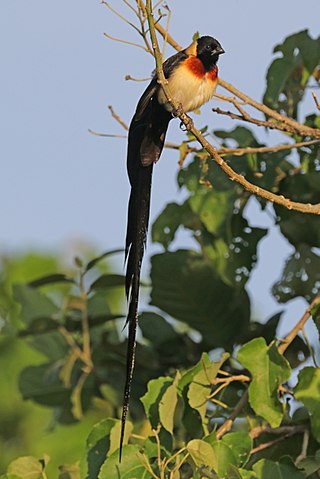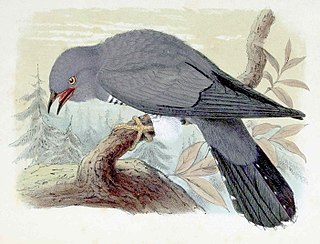
Donald Eugene Kroodsma (born 7 July 1946 in Zeeland, Michigan) is an American author and ornithologist, one of the world's leading experts on the science of birdsong. [1]

Donald Eugene Kroodsma (born 7 July 1946 in Zeeland, Michigan) is an American author and ornithologist, one of the world's leading experts on the science of birdsong. [1]
He received in 1968 his B.A. from Hope College in Holland, Michigan and in 1972 his Ph.D. from Oregon State University under John A. Wiens with dissertation Singing behavior of the Bewick's wren: development, dialects, population structure, and geographical variation. Kroodsma was from 1972 to 1974 a postdoc and from 1974 to 1980 an assistant professor at Rockefeller University. He was from 1980 to 1987 an associate professor and from 1987 to 2003 a full professor and is since 2004 a professor emeritus at the University of Massachusetts, Amherst. [1]
His research deals with vocal behavior in birds, including neural control, evolution, ontogeny, and ecology. He was an associate editor from 1996 to 2003 for the encyclopedia Birds of North America and from 1998 to 2002 for the journal The Auk .
{{cite book}}: CS1 maint: postscript (link){{cite book}}: CS1 maint: postscript (link)
The fox sparrow is a large New World sparrow. It is the only member of the genus Passerella, although some authors split the species into four.

Bird vocalization includes both bird calls and bird songs. In non-technical use, bird songs are the bird sounds that are melodious to the human ear. In ornithology and birding, songs are distinguished by function from calls.

The alder flycatcher is a small insect-eating bird of the tyrant flycatcher family. The genus name Empidonax is from Ancient Greek empis, "gnat", and anax, "master". The specific alnorum is Latin and means "of the alders".

The willow flycatcher is a small insect-eating, neotropical migrant bird of the tyrant flycatcher family. There are four subspecies of the willow flycatcher currently recognized, all of which breed in North America. Empidonax flycatchers are almost impossible to tell apart in the field so biologists use their songs to distinguish between them. The binomial commemorates the Scottish zoologist Thomas Stewart Traill.
Zoomusicology is the study of the musical aspects of sound and communication as produced and perceived by animals. It is a field of musicology and zoology, and is a type of zoosemiotics. Zoomusicology as a field dates to François-Bernard Mâche's 1983 book Music, Myth, and Nature, or the Dolphins of Arion, and has been developed more recently by scholars such as Dario Martinelli, David Rothenberg, Hollis Taylor, David Teie, and Emily Doolittle.

Animal song is not a well-defined term in scientific literature, and the use of the more broadly defined term vocalizations is in more common use. Song generally consists of several successive vocal sounds incorporating multiple syllables. Some sources distinguish between simpler vocalizations, termed “calls”, reserving the term “song” for more complex productions. Song-like productions have been identified in several groups of animals, including cetaceans, avians (birds), anurans (frogs), and humans. Social transmission of song has been found in groups including birds and cetaceans.

The long-tailed paradise whydah or eastern paradise whydah is from the family Viduidae of the order Passeriformes. They are small passerines with short, stubby bills found across Sub-Saharan Africa. They are mostly granivorous and feed on seeds that have ripen and fall on the ground. The ability to distinguish between males and females is quite difficult unless it is breeding season. During this time, the males molt into breeding plumage where they have one distinctive feature which is their long tail. It can grow up to three times longer than its own body or even more. Usually, the whydahs look like ordinary sparrows with short tails during the non-breeding season. In addition, hybridization can occur with these paradise whydahs. Males are able to mimic songs where females can use that to discover their mate. However, there are some cases where females don't use songs to choose their mate but they use either male characteristics like plumages or they can have a shortage of options with song mimicry. Paradise whydahs are brood parasites. They won't destroy the eggs that are originally there but will lay their own eggs in other songbirds nest. Overall, these whydahs are considered least concerned based on the IUCN Red List of threatened species.

HVC is a nucleus in the brain of the songbirds necessary for both the learning and the production of bird song. It is located in the lateral caudal nidopallium and has projections to both the direct and the anterior forebrain pathways.

Hammond's flycatcher is a flycatcher in the family Tyrannidae. This small insectivorous bird inhabits the coniferous and mixed forests of western North America. The name of this bird commemorates William Alexander Hammond who was the surgeon general of the US Army. Hammond collected bird specimens for Spencer Fullerton Baird.
Fernando Nottebohm is a neuroscientist and the Dorothea L. Leonhardt Professor at Rockefeller University, as well as being head of the Laboratory of Animal Behavior and director of the Field Research Center for Ecology and Ethology.
Passerine birds produce song through the vocal organ, the syrinx, which is composed of bilaterally symmetric halves located where the trachea separates into the two bronchi. Using endoscopic techniques, it has been observed that song is produced by air passing between a set of medial and lateral labia on each side of the syrinx. Song is produced bilaterally, in both halves, through each separate set of labia unless air is prevented from flowing through one side of the syrinx. Birds regulate the airflow through the syrinx with muscles—M. syringealis dorsalis and M. tracheobronchialis dorsalis—that control the medial and lateral labia in the syrinx, whose action may close off airflow. Song may, hence, be produced unilaterally through one side of the syrinx when the labia are closed in the opposite side.

The Lombard effect or Lombard reflex is the involuntary tendency of speakers to increase their vocal effort when speaking in loud noise to enhance the audibility of their voice. This change includes not only loudness but also other acoustic features such as pitch, rate, and duration of syllables. This compensation effect maintains the auditory signal-to-noise ratio of the speaker's spoken words.
Masakazu "Mark" Konishi was a Japanese neurobiologist, known for his research on the neuroscience underlying the behavior of owls and songbirds.

The brown thrasher, sometimes erroneously called the brown thrush or fox-coloured thrush, is a bird in the family Mimidae, which also includes the New World catbirds and mockingbirds. The brown thrasher is abundant throughout the eastern and central United States and southern and central Canada, and it is the only thrasher to live primarily east of the Rockies and central Texas. It is the state bird of Georgia.
Peter Robert Marler ForMemRS was a British-born American ethologist and zoosemiotician known for his research on animal sign communication and the science of bird song. A 1964 Guggenheim Fellow, he was emeritus professor of neurobiology, physiology and ethology at the University of California, Davis.
Auditory feedback (AF) is an aid used by humans to control speech production and singing by helping the individual verify whether the current production of speech or singing is in accordance with his acoustic-auditory intention. This process is possible through what is known as the auditory feedback loop, a three-part cycle that allows individuals to first speak, then listen to what they have said, and lastly, correct it when necessary. From the viewpoint of movement sciences and neurosciences, the acoustic-auditory speech signal can be interpreted as the result of movements of speech articulators. Auditory feedback can hence be inferred as a feedback mechanism controlling skilled actions in the same way that visual feedback controls limb movements.

The least flycatcher is a small insect-eating bird. It is the smallest Empidonax flycatcher in eastern North America.
Don Stap is an American author who writes poetry and nonfiction prose.

Birdsong has played a role in Western classical music since at least the 14th century, when composers such as Jean Vaillant quoted birdsong in some of their compositions. Among the birds whose song is most often used in music are the nightingale and the cuckoo.
James Roger King (1927–1991) was an American ornithologist, specializing in avian physiology.